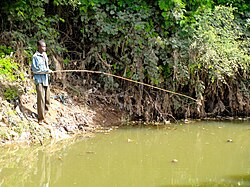Our website is made possible by displaying online advertisements to our visitors.
Please consider supporting us by disabling your ad blocker.
Common good (economics)
This article needs additional citations for verification. (May 2015) |

Common goods (also called common-pool resources[1]) are defined in economics as goods that are rivalrous and non-excludable. Thus, they constitute one of the four main types based on the criteria:
- whether the consumption of a good by one person precludes its consumption by another person (rivalrousness)
- whether it is possible to prevent people (consumers) who have not paid for it from having access to it (excludability)
As common goods are accessible by everybody, they are at risk of being subject to overexploitation which leads to diminished availability if people act to serve their own self-interests.
- ^ Mankiw, N.Gregory (2015). Principles of Economics (7th ed.). Cengage Learning, Inc. pp. 215–229. ISBN 978-1-285-16587-5.
Previous Page Next Page


